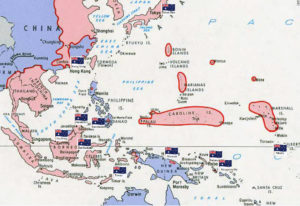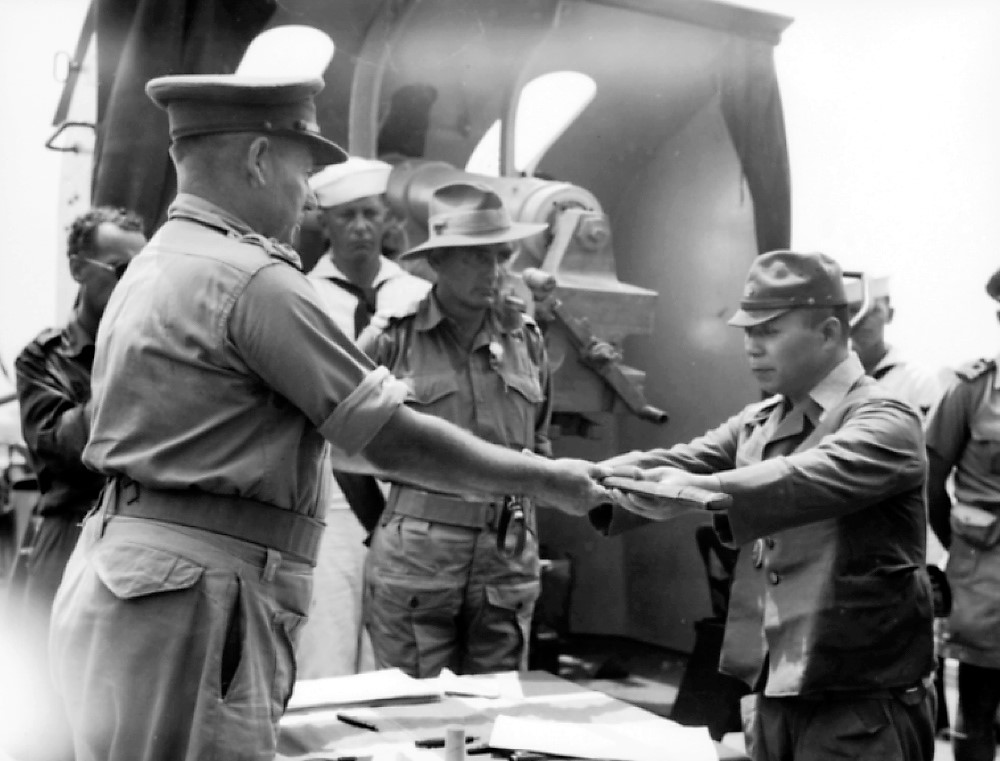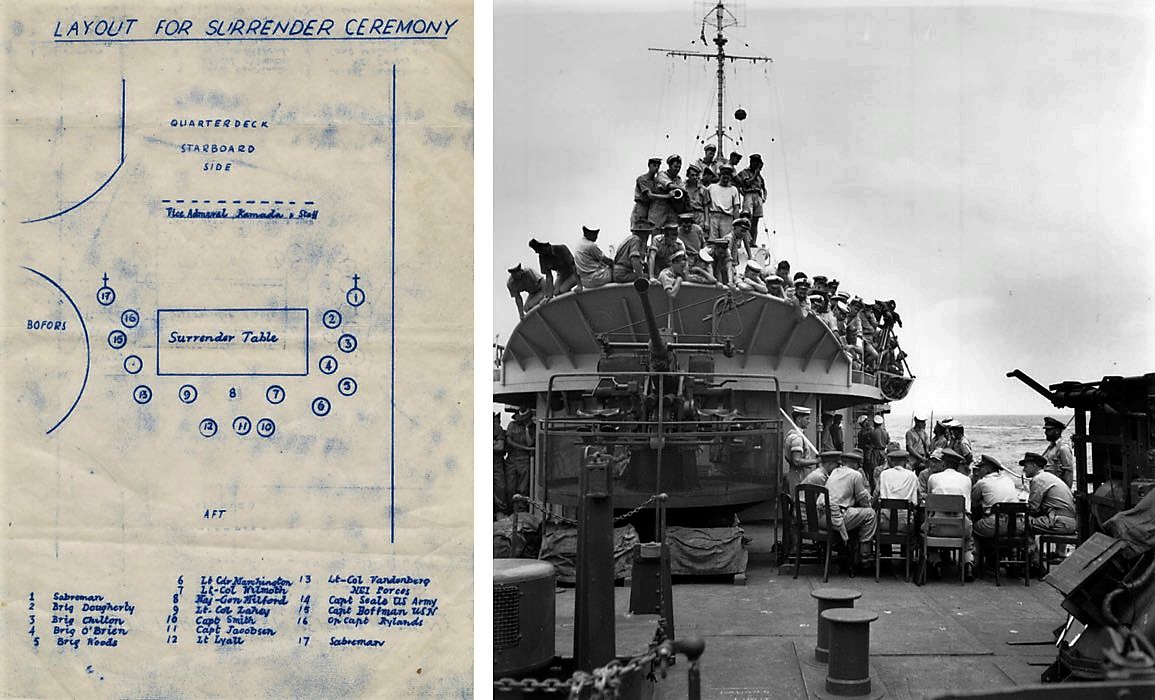By David Stratton, Hugh Farmer and Dennis Weatherall
At the end of the War in the Pacific in August 1945 the strength of the Royal Australian Navy was 36,976 men and women and 337 vessels ranging in size from cruisers to motor launches. During the course of the War it had grown from less than 5,000 personnel in December 1938 and 16 major ships. Of the 337 in service in August 1945, 57 ships were deployed in the archipelagos of the Western Pacific Ocean north of Australia.
As hostilities concluded these ships were assigned a variety of tasks which included; ferrying participants to or conducting surrender ceremonies, internee and POW repatriation, transporting troops and stores, landing occupation forces and mine sweeping operations. The following table records the location of individual ships and their employment during the weeks immediately before and after the formal Japanese surrender in Tokyo Bay on 2 September 1945.

following Cessation of Hostilities 15 August 1945
Disposition and Employment of Royal Australian Navy Ships: September 1945
| Location | Date | RAN Ships | Notes |
|---|---|---|---|
| Tokyo, Japan | 2/9/1945 | Task Group 70-9 Shropshire Hobart Bataan Warramunga Ipswich Ballarat Cessnock Napier Nizam Gascoyne Pirie | The Japanese Instrument of Surrender was signed on board the battleship USS Missouri. There was a total of 258 warships of all types from all the Allied nations which had been at war with Japan. RAN ships entered Tokyo Bay on 29 August as Task Group 70.9 within the Third Fleet. Commodore John Collins was one of the Australian representatives at the ceremony on USS Missouri. Following the ceremony RAN ships assisted with the repatriation of Allied prisoners of war. Hobart and Warramunga then sailed for Sydney while Shropshire and Bataan remained in Japanese waters until November. It was during this period that the Commanding Officer of HMAS Bataan learned of the existence of HMAS Perth survivors taken from Tokushima Camp. |
| Rabaul, Papua New Guinea | 6/9/1945 | Vendetta Dubbo Lithgow Townsville | The Instrument of Surrender for the Japanese South East Area Forces was signed on board the Aircraft Carrier HMS Glory. HMAS Vendetta embarked Brigadier Sheehan and his staff, and the Naval Officer-in-Charge, New Guinea, and his staff on 2 September before proceeding Rabaul to meet envoys from General Imamura to arrange details of the formal surrender. Vendetta remained in New Britain waters until 11 September when she proceeded for New Guinea. On her return to Sydney 3 October was decommissioned on 5 October. HMAS Dubbo was employed in preliminary minesweeping operations returning in the Solomons area prior to the surrender and later in New Britain waters. She returned to Australia in October to begin a long refit at Brisbane. HMAS Lithgow had earlier supported land operations in the Solomons before conducting minesweeping operations until the end of September. Her active war career ended on her return to Sydney on 1 November 1945. HMAS Townsville was among RAN ships which supported the Japanese surrender aboard HMS Glory. She later joined the 20th Minesweeping Flotilla clearing minefields laid in Australian coastal waters and the New Guinea /Solomons region. |
| Dutch Borneo | 8/9/1945 | Burdekin Gascoyne | HMAS Burdekin was the venue for the surrender of all Japanese forces in Dutch Borneo to Major General Milford, G.O.C., 7th Australia Division. After arriving at Balikpapan on the 8th to embarked General Milford and his staff, and a number of Army, RAAF and US Navy officers. A surrender table had been arranged on the starboard side of Burdekin’s quarterdeck. HMAS Gascoyne served in New Guinea waters from June 1945 until her eventual return to Sydney on 5 January 1946. During this time Gascoyne was engaged in escort duties and the seizure by Australian forces of the Balikpapan area in Borneo, including bombardment support for the troops ashore. In September she took part in the surrender of Japanese forces in Borneo. She was used to transport the Commanding General of the Japanese 2nd Army from the Celebes to Balikpapan on the first stage of his journey to Morotai to surrender to General Blamey. The remainder of 1945 was spent transporting troops and stores, a service which took the frigate into the Moluccas, Halmaheras, Borneo and Timor. |
| Kuching, Borneo | 9/9/1945 | Bundaberg Kapunda | HMAS Bundaberg, following the cessation of hostilities, from 16 August was involved in an unsuccessful attempt to contact the Japanese at Ambon with the object of obtaining the release of Allied war prisoners. These men were liberated some three weeks later. On 9 September Bundaberg, was at Labuan, North Borneo, with a force of RAN vessels including HMAS Kapunda for the surrender of Japanese forces in the North Borneo area. The Japanese surrender was signed on board Kapunda at Kuching on 11 September 1945. After the Surrender Bundaberg participated in the landing of occupation forces at Kuching, and in the evacuation of prisoners of war from that port to Labuan. On return to Australia Bundaberg was paid off. HMAS Kapunda assisted with the evacuation of Allied prisoners of war from Kuching following the end of the hostilities. As the headquarters ship at Kuching she provided the venue for the official surrender ceremony of the Japanese forces in the area with Major General Yamamura signing the instrument of surrender for Japanese forces in East Borneo. The surrender instrument was signed in the presence of Brigadier Eastlick, AIF. |
| Torokina, Bougainville Nauru Ocean Island, Kiribati | 8 /9/1945 1/9/1945 1/10/1945 | Diamantina | HMAS Diamantina, after completion in April 1945 commissioning and workup operated in New Guinea and adjacent waters. After the conclusion of hostilities, it was involved in transporting Japanese senior officers to from South Bougainville to Torokina where the surrender ceremony for Bougainville was conducted on 8 September 1945. Diamantina then proceeded to Nauru where she hosted the surrender of Nauru onboard and a that of Ocean Island on 1 October 1945. Australian, British and New Zealand officials were embarked for both ceremonies. She returned to Sydney in December. |
| Koepang, Timor | 11/9/1945 | Moresby Horsham Benalla Echuca Parkes Katoomba Kangaroo Bombo HDML 1322 HDML 1324 HDML 1329 | HMAS Moresby departed Darwin on 7 September 1945 in support of Operation TOFO, the surrender for all Japanese Forces in Timor. Embarked in Moresby were the Senior Naval Officer of the operation Commander GL Cant, RAN, and Brigadier LGH Dyke, CBE, DSO, who had been appointed to accept the surrender of the Japanese forces in Timor or controlled from Timor. Sailing in company with Moresby were HMA Ships Horsham, Benalla, Echuca, Parkes, Katoomba, Kangaroo, Bombo and the Harbour Defence Motor Launches (HDML) 1322, 1324 and 1329. In the convoy also were the Dutch minesweeper Abraham Crijnssen and the transport Van den Bosch. Enroute to Timor the convoy was joined by the corvettes HMAS Warrnambool and Gladstone increasing the RAN presence. On 11 September the convoy arrived at the appointed rendezvous off Koepang and two Japanese officers boarded Moresby for interrogation regarding the location of minefields and underwater obstructions. On completion of the interrogation the convoy entered harbour in column with Abraham Crijnssen sweeping ahead of the line of ships all of which were closed up at action stations. After all ships anchored off Koepang the Japanese army and navy commanders boarded Moresby and were escorted to the quarterdeck for the surrender ceremony. HMAS Moresby was again present on 3 October 1945 for another surrender ceremony which took place ashore at Koepang. On this occasion Lt. General Yamada surrendered a force of about 36,000 men who made up the Japanese forces in the entire Lesser Sunda Islands. |
| Hong Kong | 16/9/1945 | Task Force 111.2 Mildura Castlemaine Bathurst Broome Fremantle Strahan Wagga Stawell 21st Minesweeping Flotilla Ballarat Bendigo Whyalla Maryborough Burnie 22nd Minesweeping Flotilla Cessnock Geraldton Gawler Wollongong Tamworth Pirie Launceston | In mid-August 1945 eight RAN Corvettes assigned to British Task Force 111.2 under the command of Rear Admiral Harcourt worked up as minesweeping flotilla between 21 and 26 August at Subic Bay. Unfortunately for HMAS Stawell which had recently sunk a Japanese barge was denied the Hong Kong operation and remained in Subic Bay as the British Naval Liaison Officer for the port. The task group sailed for Hong Kong on 27 August and commenced sweeping operations on 29 August. The British Naval Squadron entered Hong Kong on 30th August 1945. During succeeding days more RAN corvettes arrived in Hong Kong to carry out minesweeping, anti-piracy, anti-piracy and other duties. These were the 21st and 22nd Minesweeping Flotillas. The Japanese surrender in Hong Kong took place at Government House, Hong Kong on 16 September 1945. Senior Japanese officers surrendered the territory to British officers led by Rear Admiral Jepson and witnessed by Admiral Sir Bruce Fraser. The Japanese representatives were Major General Unekichi Okada and Vice Admiral Uitaaro Fujita. |
| New Ireland, Papua New Guinea | 18/9/1945 | Swan | HMAS Swan was undergoing its third refit of the war when Japan capitulated on 15 August 1945. In September 1945 Swan proceeded to New Ireland and there on 18 September 1945 embarked General Eather, General Officer Commanding the Australian 11th Division, and his staff. On board on the same day at Namatani, General Eather accepted the surrender of Japanese forces in New Ireland from General Ito, the Japanese Commander-in-Chief. From 16 October 1945 the 20th Minesweeping Flotilla was reformed with Swan as Flotilla Leader for mine clearance operations in Australian, New Guinea and Solomon Islands waters. This vital post war work kept Swan almost constantly at sea until 16 August 1948. |
| Manado, Celebes Ambon | 22/9/1945 | Cootamundra Glenelg Rockhampton Junee Bowen | After the capitulation of Japan these ships were involved in the recovery of internees and prisoners of war and the landing of an occupation force on Ambon on 22 September 1945. |
| Singapore | 3/10/1945 | Hawkesbury | HMAS Hawkesbury, after supporting landings in Borneo, escort duties in the Netherlands East Indies and the bombardment of Japanese occupied islands she undertook a short refit in Sydney. She then escorted the repatriation transport MV Duntroon to Singapore and was present for the surrender of Singapore on 3 October 1945. She remained in Singapore until 20 September awaiting the embarkation of Australian prisoners of war. |


Surrender Ceremony on HMAS Burdekin 8 September 1945_RAN image
Associated Videos
- Video: Japanese Surrender on USS Missouri
- AWM Video: Surrender ceremony on board HMS Glory
- Video: Japanese Surrender of Hong Kong
References:
- Hermon Gill, Royal Australian Navy 1942-1945, Collins in Association with the AWM, 1968
- John Bastock, Australia’s Ships of War, Anngus and Robertson, 1975
- Sea Power Centre Australia, Ship Histories, available at https://www.navy.gov.au/fleet/ships-boats-craft/available-ship-histories, accessed 22 July 2020
- Reports of Proceedings, HMA Ships, Australian War memorial, available at https://www.awm.gov.au/collection/AWM78/, accessed 28 July 2020Occasiona




